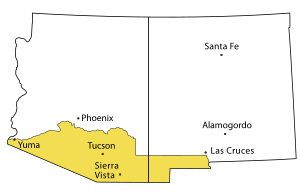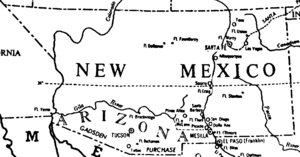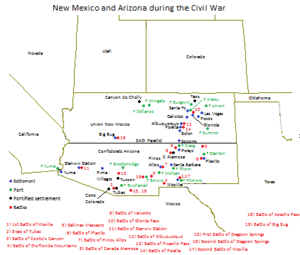Traditional Arizona facts for kids


Before Arizona became a U.S. state, the area known as Traditional Arizona was a specific region. It stretched from the Gila River south to the current Mexican border. It was also located between the Colorado River and the Rio Grande. This area includes what is now Southern Arizona, the New Mexico Bootheel, and parts of Southwestern New Mexico. The U.S. gained this land from Mexico in 1853 through the Gadsden Purchase. People in Traditional Arizona mostly worked in mining and ranching. However, growing citrus fruits had been common in Tucson for a long time.
History of Early Arizona
Life Before the Civil War
Many of the first settlers in Arizona came from areas that were once part of the Republic of Texas. Others came from the heart of the region around Tucson, Arizona. These settlers arrived during the California Gold Rush in the 1840s. They kept their connections to the east through Mesilla, which was on Arizona's border with Texas. From there, they connected to San Antonio, Texas. Most other settlers came from different parts of the U.S.. Some Mexican citizens from Sonora and settlers from the Midwest also moved there.
Texas was very important for Arizona, providing a vital link. Later, when California became a U.S. state, Arizona had two ways to get supplies and communicate. The main route was the Butterfield Overland Mail company, which ran through southern Arizona. Traditional Arizona was never part of William Walker's Republic of Sonora. That republic was formed in January 1854, a year after the Gadsden Purchase made Traditional Arizona part of the United States.
Arizona During the Civil War
The mail line closing was a big reason why Arizona wanted to leave the Union. They also asked to join the Confederacy. Another major concern was the constant Apache attacks in southern Arizona. People in Arizona were upset because there were not enough U.S. soldiers to protect them.
Arizona became a separate territory after the First Battle of Mesilla. In this battle, future governor, John R. Baylor, defeated the Union soldiers at Fort Fillmore. He had help from Arizona's local militia. Mesilla and Tucson became important towns for the Confederacy in the region. Tucson was an old Spanish fort, called a presidio. It had strong adobe walls and had seen many Apache battles before. Tucson was also the largest town in Southern Arizona at that time. Its citizens had even asked the U.S. government to create a Union Arizona territory back in 1859, but this request was denied.
Even though Tucson had strong walls, it had no soldiers when the war started. It was an open city until a small militia was formed. Tubac, south of Tucson, was another old Spanish fort. Tucson's militia rescued the people of Tubac during the Siege of Tubac in the spring of 1861. This was led by Captain Granville Henderson Oury.
After John R. Baylor became Governor of Arizona, two district courts were set up. The Confederates made Mesilla the capital and home of the first court. This was because it was close to Texas and not across the large desert near Tucson. Tucson became home to the second court. Soon after Confederate Arizona was officially created in early 1862, rebels from Texas and Arizona defeated a Union cavalry group at the Battle of Canada Alamosa.
When Confederate General Henry Hopkins Sibley started his New Mexico Campaign, he wanted to capture Union New Mexico. He sent a company of Arizona militia and Texas Mounted Rifles to hold Tucson. These about 75 men were led by Captain Sherod Hunter. General Sibley then fought the Battle of Valverde, north of Mesilla. Several other fights happened near Confederate Arizona's border with Union New Mexico.
Sibley's army, which included many Arizona militia, won a tactical victory at the Battle of Glorieta Pass. However, they had to retreat because they lost their supplies. At the same time, the region faced the worst Apache conflict in its American history. In the early 1860s, Mangas Coloradas and Cochise led thousands of Apache warriors in many battles. Apaches attacked the Pinos Altos mining town in Traditional Arizona. This was a major fight between rebel Arizona militia and Apache warriors. Placito was also attacked. Again, Confederate States Army troops and Arizona militia successfully fought off the Apaches.
After the New Mexico Campaign failed, Confederate Arizona's time was ending. Union forces moved south from Fort Union. The California Column invaded Arizona from the west. The Californians, led by Colonel James H. Carleton, captured the Confederate Fort Yuma. This fort was on Traditional Arizona's side of the Colorado River. There was no fight because the rebel soldiers left for Mexico before Colonel Carleton arrived. The Californians then moved on, using the old Butterfield Mail route. Tucson's soldiers were ordered to slow down the Union invasion from the west. They burned several hay stations, which were old mail stations abandoned before the war.
Californians and Confederates, led by Second Lieutenant John W. Swilling, fought a small battle at Stanwix Station. Slowly, Union scouts reached the Pima Villages. Eight Federal troops were captured there by the Confederates without a fight. Before the Californian invasion, the Union had sent spies into the region. Their job was to get food and hay for the California Column. These supplies were stored in abandoned Butterfield Mail stations, including one at the Pima Villages. When Carleton's main group reached the Pima Villages, they found that Confederate forces had taken their needed food. The Confederates had resold it to the Pimas.
Since they had gone too far to turn back, the Californians moved toward Tucson. Confederate scouts waited for the Union advance at Picacho Peak. Their mission was to spot the California Column and then return to Tucson to warn Captain Sherod Hunter and his men. An advance Union cavalry patrol found the rebel camp at Picacho Peak and attacked. The Battle of Picacho Peak was fought, and the Union cavalry went back to their main group.
At this time, Tucson was about to fall. No Confederate reinforcements had arrived. Sherod Hunter, with only one company and some Tucson militia, faced a Union army of over 2,000 soldiers. Since victory was impossible, most of the soldiers left just before the Capture of Tucson. A small group of Confederate troops was ordered to stay behind, led by a Lieutenant. These men barely escaped the Union advance on the city. The lieutenant later reported that the Californians surrounded Tucson. They then launched a full attack with soldiers and cavalry, expecting a battle. The Union troops entered the town as their band played Yankee Doodle. The rebels almost fought but were convinced not to by an unknown Tucson woman.
Tucson fell, so the Union forces moved further south along the old mail route. In May, a group from Sherod Hunter's company fought two battles with Apaches in the Dragoon Mountains of Traditional Arizona. The Union forces reached Mowry, Arizona and arrested former United States Army Lieutenant Sylvester Mowry at his mining camp.
The former lieutenant, who supported the Confederacy in Arizona, was accused of selling lead to rebels for bullets. He was sent west and jailed in Yuma Territorial Prison from July 2 to November 9, 1862. He was released after a trip to Yuma's courthouse. In his defense, he spoke about the basic American ideas of Life, Liberty and the Pursuit of Happiness. After the judge heard this, Mowry was released. Many Arizonans at the time felt the same way as Lieutenant Mowry. They believed that eastern New Mexico Territory was a place of great American progress. But the southwestern area, known as Arizona, was a war zone. It was not suitable for life, had no contact with the east, and no protection against Apaches. This was true: Lieutenant Mowry's mine was destroyed by Apaches sometime after his arrest.
The Californians moved further, took over southern Arizona's forts, and left soldiers behind, including in Tucson. Once in Apache Pass, some of Carleton's men were ambushed by Apaches. These Apaches were led by Cochise, Mangas Coloradas, and Geronimo. They fought the Battle of Apache Pass in mid-June 1862 and won. Fort Bowie was built as a result. It was meant to protect settlers from hostile Native Americans and to protect the nearby Butterfield Overland Mail station. Soon after the battle in Apache Pass, Mesilla fell without bloodshed, and Confederate Arizona ended. The Union created their own Arizona Territory in 1863, with Tucson as the capital. However, they did not include Mesilla and its surrounding areas. This meant Arizona no longer bordered Texas. The Arizonans of Mesilla, Pinos Altos, and other towns had to remain citizens of New Mexico.


